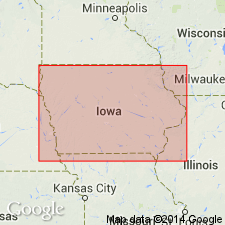
- Usage in publication:
-
- Spechts Ferry member
- Modifications:
-
- Original reference
- Dominant lithology:
-
- Shale
- Limestone
- AAPG geologic province:
-
- Iowa shelf
- Wisconsin arch
Summary:
Spechts Ferry member of Decorah formation. Basal member of Decorah formation. At type locality consists of 8.5 feet of shales and interbedded limestones. It includes the "glass rock" and overlying shales at top of typical Platteville. Fossils are of latest Black River (Watertown) age. Overlies Platteville limestone and underlies Guttenberg limestone member of Decorah formation. [See also Kay, Jour. Geol., v. 37, no. 7, Oct.-Nov. 1929, p. 639-671, where he stated this member corresponds to RHINIDICTYA bed and STICTOPORELLA bed of Minnesota.]
Type locality: ravine southwest of Chicago, Milwaukee, St. Paul, and Pacific RR station of Spechts Ferry, Dubuque Co., IA.
Source: US geologic names lexicon (USGS Bull. 896, p. 2037).
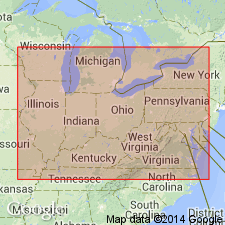
- Usage in publication:
-
- Spechts Ferry member
- Modifications:
-
- Revised
- AAPG geologic province:
-
- Iowa shelf
- Wisconsin arch
Summary:
Pg. 370. Spechts Ferry member of Decorah formation. Redefined Spechts Ferry member by excluding the "glass rock," which he stated was found to be older than the 8.5 feet of shales with intercalated thin limestones in type section of the member. Age is Middle Ordovician (late Black River).
Source: US geologic names lexicon (USGS Bull. 896, p. 2037).
- Usage in publication:
-
- Spechts Ferry member
- Modifications:
-
- Areal extent
- AAPG geologic province:
-
- Iowa shelf
- Wisconsin arch
Bays, C.A., and Raasch, G.O., 1935, Mohawkian relations in Wisconsin: Kansas Geological Society Guidebook for the Annual Field Conference, August 25-September 1, 1935, no. 9, p. 296-301., Prepared in cooperation with Iowa, Illinois, Wisconsin, and Minnesota geol. surveys
Summary:
Pg. 297-299. Spechts Ferry member of Platteville limestone. Removed from McGregor member of Kay its upper part and renamed these upper beds Magnolia member. Their Magnolia member underlies Spechts Ferry member of Kay. [Age is Middle Ordovician (late Black River).]
Source: US geologic names lexicon (USGS Bull. 896, p. 2037).
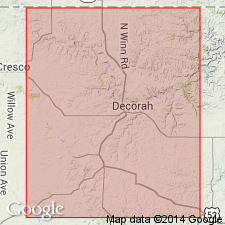
- Usage in publication:
-
- Spechts Ferry member
- Modifications:
-
- Revised
- AAPG geologic province:
-
- Iowa shelf
- Wisconsin arch
Summary:
Pg. 286-287. Spechts Ferry member of Platteville limestone. Treated Spechts Ferry member as top member of Platteville; named the underlying (conformable) beds McGregor member; called the overlying beds Guttenberg member of Decorah formation; included the "glass rock" in top of his McGregor member; and classified his Spechts Ferry member as of Black River age. He also further redefined the member by transferring to overlying Guttenberg member of Decorah "the 10-inch beds of limestone containing pyritic and phosphatic nodules originally considered as the top of the member." On p. 285, 288 he stated: Spechts Ferry member is stratigraphically and faunally more closely related to underlying members of Platteville formation. But northern extension of the member, being succeeded by other more calcareous shales with which it comprises a lithologic unit, it is more convenient to consider the Spechts Ferry as a lowest member of Decorah formation in Minnesota and northern Iowa. On p. 295 he showed an unconformity between his Guttenberg and Spechts Ferry members in Minnesota and Illinois. Age is Middle Ordovician (late Black River).
Source: US geologic names lexicon (USGS Bull. 896, p. 2037).
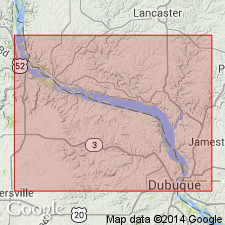
- Usage in publication:
-
- Spechts Ferry member
- Modifications:
-
- Areal extent
- AAPG geologic province:
-
- Iowa shelf
- Wisconsin arch
Summary:
Pg. 101. Spechts Ferry member of Decorah formation. Continued to include Spechts Ferry member in the Decorah and to classify it as of late Black River age and rest of Decorah as Trenton.
Source: US geologic names lexicon (USGS Bull. 896, p. 2037).

- Usage in publication:
-
- Spechts Ferry member
- Modifications:
-
- Overview
- AAPG geologic province:
-
- Iowa shelf
- Wisconsin arch
Summary:
The Committee of 9th Ann. Conf. Rpt. Kansas Geol. Soc., 1935, transferred these beds to Platteville limestone, and restricted Decorah shale to Ion and Guttenberg members of Kay. These changes have not yet been considered by the USGS for its publications.
Source: US geologic names lexicon (USGS Bull. 896, p. 2037).
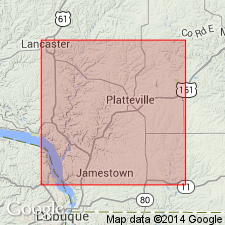
- Usage in publication:
-
- Spechts Ferry member
- Modifications:
-
- Revised
- AAPG geologic province:
-
- Wisconsin arch
Summary:
Pg. 1585-1587. Spechts Ferry shale member of Decorah formation. Overlies Quimbys Mill member (new) of Platteville formation. Limestone unit included in Quimbys Mill has sometimes been referred to as lithologic facies of the Spechts Ferry. Age is Middle Ordovician.
Source: US geologic names lexicon (USGS Bull. 1200, p. 3679).
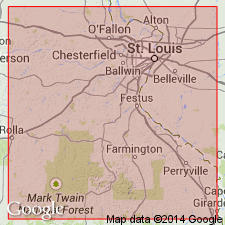
- Usage in publication:
-
- Spechts Ferry shale member
- Modifications:
-
- Areal extent
- AAPG geologic province:
-
- Ozark uplift
Summary:
Pg. 2045 (fig. 3), 2064, 2065. Spechts Ferry shale member of Decorah formation. Geographically extended into St. Louis County, Missouri, where it overlies Macy formation (new) of Plattin group. Age is Middle Ordovician.
Source: US geologic names lexicon (USGS Bull. 1200, p. 3679).
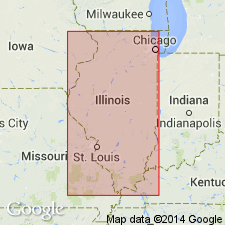
- Usage in publication:
-
- Spechts Ferry formation
- Modifications:
-
- Revised
- AAPG geologic province:
-
- Wisconsin arch
Summary:
Pg. 6, fig. 3. Spechts Ferry formation of Galena group. Considered basal formation in Galena group in Dixon-Oregon area, Illinois. Age is Middle Ordovician.
Source: US geologic names lexicon (USGS Bull. 1200, p. 3679).
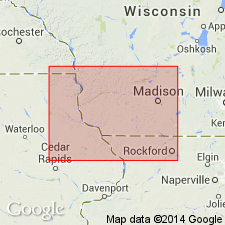
- Usage in publication:
-
- Spechts Ferry shale member*
- Modifications:
-
- Areal extent
- AAPG geologic province:
-
- Iowa shelf
- Wisconsin arch
Summary:
Pg. 263 (fig. 36), 268 (fig. 38), 286-289. Spechts Ferry shale member of Decorah formation. Consists of green fossiliferous shale, greenish-buff fine-grained limestone, phosphatic nodules near top; bentonite near base. Thickness at type locality about 8 feet; thins to east at Shullsburg, Wisconsin. Underlies Guttenberg member; near Decorah, Iowa, basal green shale of Spechts Ferry thickens at expense of Guttenberg limestone. Age is Middle Ordovician.
Source: US geologic names lexicon (USGS Bull. 1200, p. 3679).
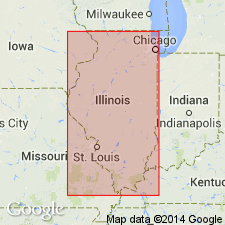
- Usage in publication:
-
- Spechts Ferry Formation
- Modifications:
-
- Overview
- AAPG geologic province:
-
- Illinois basin
Summary:
Spechts Ferry Formation of Decorah subgroup [informal] of Galena Group used in Illinois. Exposed in northwestern Illinois along Galena River in Jo Daviess County and in small areas near West Point Landing in Calhoun County, and Valmeyer, Monroe County. Absent in central and eastern parts of Illinois. Subdivided into Castlewood and Glencoe Members. Includes abundant PIONODEMA SUBAEQUATA and other common Trentonian fossils, including bryozoans. Spechts Ferry Formation is STICIPORELLA bed of early reports. Overlies Quimbys Mill Formation; basal beds of Spechts Ferry contain fragments of Quimbys Mill. Correlates with Selby Member of Rockland Formation in New York and Curdville Limestone in Kentucky and Tennessee.
["Subgroup" not recognized as a formal stratigraphic rank term (CSN, 1933; ACSN, 1961, 1970; NACSN, 1983, 2005, 2021). Considered informal and should not be capitalized.]
Source: Modified from GNU records (USGS DDS-6; Reston GNULEX).
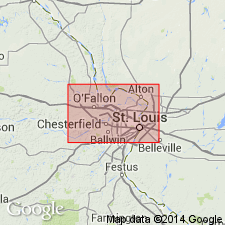
- Usage in publication:
-
- Spechts Ferry Formation*
- Modifications:
-
- Areal extent
- AAPG geologic province:
-
- Illinois basin
- Ozark uplift
Summary:
Used as Spechts Ferry Formation of Decorah Group of Middle Ordovician (Mohawkian) age in MO and IL in St. Louis area, MO. Includes Castlewood Limestone Member and Glencoe Shale Member. Deike K-Bentonite Bed of Willman and Kolata (1978) occurs near base of Castlewood Limestone Member. Millbrig K-Bentonite Bed of Willman and Kolata (1978) is interbedded with Glencoe Shale Member. Isotopic ages for Millbrig are 453.7+/-1.8 Ma (Tucker and others, 1990) and 454.1+/-2.1 Ma (Kunk and others, 1985). Glencoe and Castlewood share same type section on southeast bank of Meramec River in SE/4 SE/4 sec. 21, T. 44 N., R. 4 E., Manchester 7.5-min quad, St. Louis Co., MO. [Author follows usage of Thompson (1991).]
Source: GNU records (USGS DDS-6; Reston GNULEX).
For more information, please contact Nancy Stamm, Geologic Names Committee Secretary.
Asterisk (*) indicates published by U.S. Geological Survey authors.
"No current usage" (†) implies that a name has been abandoned or has fallen into disuse. Former usage and, if known, replacement name given in parentheses ( ).
Slash (/) indicates name conflicts with nomenclatural guidelines (CSN, 1933; ACSN, 1961, 1970; NACSN, 1983, 2005, 2021). May be explained within brackets ([ ]).

